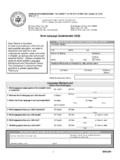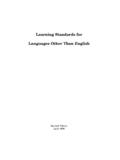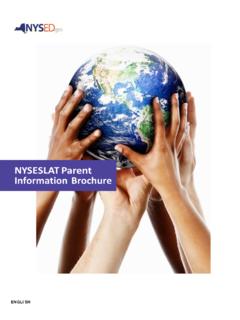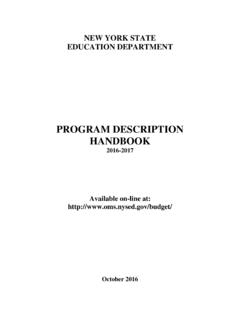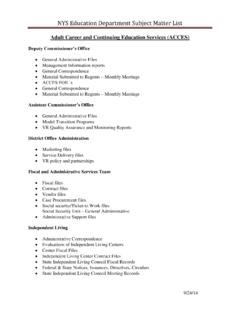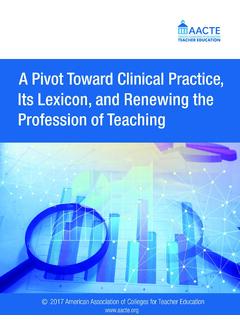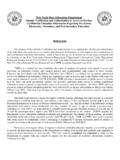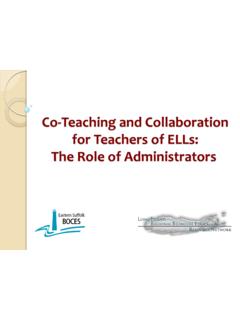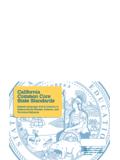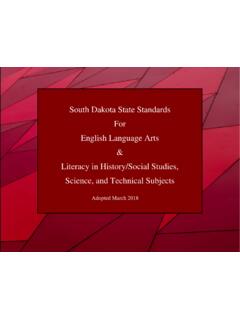Transcription of New York State Next Generation English Language Arts ...
1 New York State Education Department English Language arts LEARNING STANDARDS 1 NEW YORK State EDUCATION DEPARTMENT GRADE P-12 New York State next Generation English Language arts Learning Standards REVISED 2017 New York State Education Department English Language arts LEARNING STANDARDS (2017) 2 NEW YORK State EDUCATION DEPARTMENT Table of Contents Anchor Standards .. 3 Lifelong Practice of Readers and Writers .. 8 Prekindergarten and Elementary Standards .. 9 Middle Grades Standards .. 71 High School Standards .. 96 Appendix A ( Language Standard 1 and 2) .. 117 Appendix B: Glossary of 124 New York State Education Department English Language arts LEARNING STANDARDS (2017) 3 NEW YORK State EDUCATION DEPARTMENT English Language arts Anchor Standards Anchor standards represent broad statements about the expectations for students as they prepare for high school graduation, positioning them for college and careers.
2 The grade level ELA standards begin in the Prekindergarten and Elementary ELA Standards section. Please see the introduction for more about how the anchor standards and grade level standards connect. New York State Education Department English Language arts LEARNING STANDARDS (2017) 4 NEW YORK State EDUCATION DEPARTMENT Reading Anchor Standards PLEASE NOTE: For the grade level and grade band standards, RI and RL are included to show how the standard applies to either reading informational (RI) or literary texts (RL), or both (RI&RL). Key Ideas and Details STANDARD 1: Read closely to determine what the text says explicitly/implicitly and make logical inferences from it; cite specific textual evidence when writing or speaking to support conclusions drawn from the text. STANDARD 2: Determine central ideas or themes of a text and analyze their development; summarize the key supporting details and ideas.
3 STANDARD 3: Analyze how and why individuals, events, and ideas develop and interact over the course of a text. Craft and Structure STANDARD 4: Interpret words and phrases as they are used in a text, including determining technical, connotative, and figurative meanings, and analyze how specific word choices shape meaning or tone. STANDARD 5: Analyze the structure of texts, including how specific sentences, paragraphs, and larger portions of the text ( , a section, chapter, scene, or stanza) relate to each other and the whole. STANDARD 6: Assess how point of view or purpose shapes the content and style of a text, drawing on a wide range of global and diverse texts. Integration of Knowledge and Ideas STANDARD 7: Integrate and evaluate content presented in diverse media and formats. STANDARD 8: Delineate and evaluate the argument and specific claims in a text, including the validity of the reasoning as well as the relevance and sufficiency of the evidence.
4 STANDARD 9: Analyze and evaluate texts using knowledge of literary forms, elements, and devices through a variety of lenses and perspectives. New York State Education Department English Language arts LEARNING STANDARDS (2017) 5 NEW YORK State EDUCATION DEPARTMENT Writing Anchor Standards Text Types and Purposes STANDARD 1: Write arguments to support claims in an analysis of substantive topics or texts, using valid reasoning and relevant and sufficient evidence. STANDARD 2: Write informative/explanatory texts to examine and convey complex ideas and information clearly and accurately through the effective selection, organization, and analysis of content. STANDARD 3: Write narratives to develop real or imagined experiences or events using effective techniques, well-chosen details, and well-structured event sequences. STANDARD 4: Develop personal, cultural, textual, and thematic connections within and across genres through written responses to texts and personal experiences.
5 STANDARD 5: Draw evidence from literary or informational texts to support analysis, reflection, and research. Research to Build and Present Knowledge STANDARD 6: Conduct research based on focused questions to demonstrate understanding of the subject under investigation. STANDARD 7: Gather relevant information from multiple sources, assess the credibility and accuracy of each source, and integrate the information in writing while avoiding plagiarism New York State Education Department English Language arts LEARNING STANDARDS (2017) 6 NEW YORK State EDUCATION DEPARTMENT Speaking and Listening Anchor Standards Comprehension and Collaboration STANDARD 1: Prepare for and participate effectively in a range of conversations and collaborations with diverse partners; express ideas clearly and persuasively, and build on those of others. STANDARD 2: Integrate and evaluate information presented in diverse media and formats (including visual, quantitative, and oral).
6 STANDARD 3: Evaluate a speaker s point of view, reasoning, and use of evidence and rhetoric. Presentation of Knowledge and Ideas STANDARD 4: Present information, findings, and supporting evidence so that listeners can follow the line of reasoning. Ensure that the organization, development, and style are appropriate to task, purpose, and audience. STANDARD 5: Make strategic use of digital media and visual displays to express information and enhance understanding of presentations. STANDARD 6: Adapt speech to a variety of contexts and communicative tasks, demonstrating command of academic English when indicated or appropriate. New York State Education Department English Language arts LEARNING STANDARDS (2017) 7 NEW YORK State EDUCATION DEPARTMENT Language Anchor Standards Conventions of Academic English / Language for Learning STANDARD 1: Demonstrate command of the conventions of academic English grammar and usage when writing or speaking.
7 STANDARD 2: Demonstrate command of the conventions of academic English capitalization, punctuation, and spelling when writing. Knowledge of Language STANDARD 3: Apply knowledge of Language to understand how Language functions in different contexts, to make effective choices for meaning or style, and to comprehend more fully when reading or listening. Vocabulary Acquisition and Use STANDARD 4: Determine or clarify the meaning of unknown and multiple-meaning words and phrases by using context clues, analyzing meaningful word parts, and consulting general and specialized reference materials, as appropriate. STANDARD 5: Demonstrate understanding of figurative Language , word relationships and nuances in word meanings. STANDARD 6: Acquire and accurately use general academic and content-specific words and phrases sufficient for reading, writing, speaking, and listening; demonstrate independence in gathering and applying vocabulary knowledge when considering a word or phrase important to comprehension or expression.
8 New York State Education Department English Language arts LEARNING STANDARDS (2017) 8 NEW YORK State EDUCATION DEPARTMENT Lifelong Practices of Readers and Writers Lifelong Practices of Readers Lifelong Practices of Writers Readers: think, write, speak, and listen to understand read often and widely from a range of global and diverse texts read for multiple purposes, including for learning and for pleasure self-select texts based on interest persevere through challenging, complex texts enrich personal Language , background knowledge, and vocabulary through reading and communicating with others monitor comprehension and apply reading strategies flexibly make connections (to self, other texts, ideas, cultures, eras, etc.) Writers: think, read, speak, and listen to support writing write often and widely in a variety of formats, using print and digital resources and tools write for multiple purposes, including for learning and for pleasure persevere through challenging writing tasks enrich personal Language , background knowledge, and vocabulary through writing and communicating with others experiment and play with Language analyze mentor texts to enhance writing strengthen writing by planning, revising, editing, rewriting, or trying a new approach New York State Education Department English Language arts LEARNING STANDARDS (2017) 9 NEW YORK State EDUCATION DEPARTMENT Prekindergarten and Elementary English Language arts Learning Standards Prekindergarten.
9 10 18 Grade 1 .. 27 Grade 2 .. 35 Grade 3 .. 45 Grade 4 .. 54 Grade 5 .. 63 New York State Education Department English Language arts LEARNING STANDARDS (2017) 10 NEW YORK State EDUCATION DEPARTMENT Prekindergarten English Language arts Learning Standards PLEASE NOTE: These Standards are intended for four-year-old prekindergarten students. Prekindergarten Introduction Guidance and Support Guidance and support are an integral part of developmentally appropriate practice. As children are gaining mastery of the standards in prekindergarten, some students may require support to demonstrate skills. Range of Student Reading Experiences for Prekindergarten Students in prekindergarten should experience a balance of literature and informational texts in the context of instruction designed to create opportunities for children to engage with a variety of topics, and texts, and have discussions about texts that support Language development and knowledge building.
10 Creating this learning environment for emergent readers can take a variety of formats, including read-alouds, shared readings, pretend readings, learning activities and play that incorporate literacy materials, talking, experimenting with written materials, and other literacy activities. We refer to these instructional events as reading or literacy experiences because the focus is on using texts, printed and visual, to develop emergent readers concepts of how meaning is conveyed through reading and writing while building their Language and knowledge. It is not enough to simply feature a variety of literary and informational text types in Prekindergarten environments and classroom instruction; these texts must be made accessible and meaningful to young readers as a component of fostering engagement with literacy to build Language and knowledge. For example, educators should provide and engage developing readers with an assortment of fiction and non-fiction age-appropriate books in the library area that are displayed attractively and used regularly, rotated often; connected to instructional themes and feature cultural diversity; incorporate text materials into many different aspects of the classroom curriculum, including authentic informational text materials for use in play and to guide learning centers; and select a variety of text types that engage children s interests and support their learning about the themes under study.


